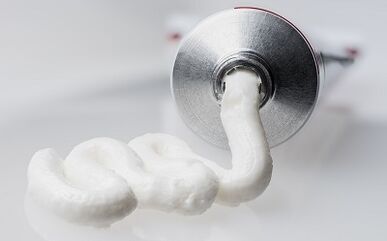A sedentary lifestyle, typical of most modern people, often leads to diseases of the musculoskeletal system. One of them is cervical osteochondrosis. Recently, this disease has become much younger and its symptoms are often found in people over 25 years old. If left untreated, the condition can lead to dangerous consequences.
Causes of the pathology

The main cause of cervical osteochondrosis is incorrect load distribution in the spine. The factors that lead to this may be different. Let's say a person is used to carrying a heavy bag on one shoulder, sleeping or sitting in the wrong position, and so on. It seems that these factors are insignificant, but when they work for a long time, they lead to a completely logical consequence - osteochondrosis of the cervical spine.
The risk factors that increase the likelihood of pathology are as follows:
- overweight;
- lack of physical activity;
- transfer of spinal injuries;
- posture disorders;
- foot pathology;
- deterioration of the blood supply to the cervical spine.
These reasons lead to the formation of an incorrect position of the vertebrae. Weight is unevenly distributed across the vertebrae, which is why some parts of the cervical spine are under excessive stress. In response to this, tissue changes occur.
The following factors can also aggravate the situation:
- the transfer of a serious illness or injury, leading to exhaustion of the body;
- constant stress;
- metabolic disorders in the body;
- insufficient use of trace elements, their excessive consumption or insufficient absorption by the intestines;
- occupational illnesses (in particular vibration illnesses);
- genetic predisposition to osteochondrosis;
- scoliosis and other posture disorders;
- non-compliance with the drinking regime;
- inadequate nutrition;
- bad habits;
- pregnancy.
Most of the time, SHOX triggers a series of factors. In its occurrence, lifestyle, general health and the presence of background pathologies play a role.
disease symptoms
<2_img_rightxx>Even in the initial phase, it can be recognized by the following symptoms:
The most common symptom is dizziness. May be accompanied by:
Patients often suffer from headaches, especially women. Sometimes he manifests:
How is a problem diagnosed in this part of the spine?
SHOX is diagnosed by the following methods:
- Radiography. This method is not always effective, especially in the later stages of the pathology.
- Magnetic resonance. Allows you to see bone structures, hernias, their size and direction of development.
- CT. Computed tomography is less effective than MRI as hernias and their size are difficult to determine with this method.
- Ultrasonic duplex scanning. This method is used if impaired blood flow in the arteries is suspected. The scan allows you to assess the speed of blood flow and the presence of obstacles to it.
Peculiarities
<3_img_leftxx>The disease can progress in different ways. Sometimes it compensates, sometimes exacerbations arise.
Along with the pathological process, compensation mechanisms are activated, prolonging the functions of the vertebrae for some time and eliminating the symptoms. But as the disease progresses, it leads to the destruction of the fibrous ring and the appearance of micro-cracks. The vertebrae lose fixation and stability.
Furthermore, osteochondrosis is characterized by the impregnation of the pulp from the space between the vertebrae with calcium. Therefore, a kind of hernia is formed, as the affected vertebra is pressed against the body of the person next to it.
Structures wear out over time, resulting in massive ossification.
Stages
The course of the disease is divided into several phases:
- Stage 1.Instability of vertebral structures and disc disorders.
- Step 2.Decreased fixation of vertebral sections, disc protrusion.
- Step 3.Fibrous ring rupture, obvious symptoms and pain.
- Step 4.Movement difficulty, severe sharp pain, bone tissue spread.
Due to the peculiarities of the location of blood vessels and muscles, the neck is vulnerable areas. With a long course of osteochondrosis, numerous complications arise, many of which pose a serious danger to human health.
How to provide first aid at home?
Home treatment of cervical osteochondrosis includes:
It is together that the therapeutic methods allow to obtain good results in the treatment of cervical osteochondrosis. Symptoms of the disease can cause severe discomfort, so you need to know how to give first aid.
Medicines
Various medications are used to fight the symptoms of the disease. They should be prescribed by a doctor who specializes in the treatment of osteochondrosis - a neurologist or a vertebrologist.
Medicines

For the treatment of SHOC, the following groups of drugs are prescribed:
- Non-steroidal anti-inflammatory drugs. Helps relieve pain, swelling and inflammation of the affected nerve root.
- B group vitamins. They help to improve metabolic processes in nervous tissues.
- Chondroprotectors. Promotes restoration of cartilage tissue.
- Muscle relaxants. Helps reduce muscle spasms.
- Medicines that aim to improve the rheological properties of blood and blood flow. They help to improve the blood flow process to the brain and nourish the affected nerve endings.
Intramuscular injections may also be indicated.
ointments

Osteochondrosis ointments help to eliminate unpleasant symptoms in the early stages of the pathology. They are classified according to their effect on the body:
Massage

Massage helps to strengthen muscle tone and relieve pain. Your technique is selected depending on the stage of the disease. But, in most cases, all the techniques of classical massage are used: rubbing, caressing, kneading, and so on.
- If the patient's pain is on one side only, the massage begins in a healthy area, gradually moving to where the pain occurs.
- The first session should last no longer than seven minutes. Then, each procedure is increased by 1-2 minutes until the session time reaches 12 minutes.
- The patient should lie prone, placing the forehead on the cysts and arms and stretching the chin towards the chest. It is important that the neck muscles are relaxed.
On its own
Massage can be done at home, but in this case, you need to be very careful not to hurt yourself further. Self-massage with SHOX includes the following classic techniques:
Physiotherapy
Corrective gymnastics helps to improve the patient's condition. But it will be safer during the recovery period. While running, the patient should not experience pain and discomfort. The exercises aim to strengthen the muscles in the neck.
Complex exercise therapy

The gym complex must be selected by a physician. The following exercises are helpful:
Complementary Therapy
Treatment can be complemented by physical therapy methods, in addition to the use of various devices, such as massagers.
Massagers
Using massagers helps speed recovery. It should be noted that they have a number of contraindications and can only be used with a doctor's permission. With osteochondrosis of the cervical spine, it is often used:
- applicator;
- heating massagers;
- devices for the neck and shoulders.
Applicator

The applicator is a pillow or mat with plastic or metal tips.
It acts on specific points that respond to all biological processes in the body.
Using the product helps achieve the following results:
The device must be used in accordance with the instructions.
Physiotherapy
The following methods can be indicated from physiotherapy for SHH:
- Electrophoresis. . . It is combined with medications that immediately enter the desired area by the effect of an electrical current.
- Ultrasound.Relieves pain and inflammation, helps improve metabolic processes.
- Magnetotherapy.Relieves tissue swelling, thus minimizing pain.
- Laser therapy.Eliminates inflammation and improves blood circulation.
folk remedies
Time-tested popular recipes can be used as an add-on treat.
Kerosene compress
A warming compress with kerosene helps to quickly relieve pain.
Scrubbing of pharmaceutical preparations
Infusion of pine buds

Pine infusion in the kidneys allows, for a minimum period of time, to obtain a long-term remission in case of pain in the cervical spine due to osteochondrosis.
This medicine should be prepared in advance and consumed for a long time, but the results will bring the long-awaited effect for many months.
Preparation:
The admission course is 2-3 weeks.
potato compress
You can get rid of pain in three days.
radish sauce
honey bandage
Repeat the procedure every night.
conifer broth
The course of therapy lasts for a month.
dandelion broth
<10_img_rightxx>Dandelion's most important medicinal properties are associated with the content of inulin, a large amount of amino sugars, natural rubber.
The plant is also valued for its taraxacin glycoside content, triterpene compounds, fatty oil, organic acids and alcohols, resinous compounds, bioflavonoids, as well as a number of mineral compounds, including the necessary calcium.
Preparation:
ginger ointment
Mustard Egg Mix
You need to mix:
- 50 g of powdered mustard;
- 3 beaten egg whites;
- 50 ml of camphor alcohol;
- 59 ml of vodka or medicinal alcohol.
The product is infused in a dark place for 10-12 hours.
To prepare the second mix, you need to mix:
- 100 g of honey;
- 50 g of aloe juice;
- 150 ml of vodka or diluted alcohol.
The makeup is placed in a dark place for 12 hours.
Funds are applied twice a day, applying to the affected area and remaining there until drying. It is recommended to combine them until they run out. A 12-day course will help you forget about pain for several months.
What to do in case of severe pain?
<11_img_rightxx>It should be emphasized that osteochondrosis therapy must be performed in a complex way.
First of all, you must remove all pain in the neck and head, eliminate the root causes that cause discomfort.
If the patient treats extremely severe pain, it will not be possible to get rid of the main problem.
dizziness relief
Medicines help:
- muscle relaxants;
- vasodilators;
- anti-inflammatory drugs and analgesics.
Gymnastics and physiotherapy are also useful in the therapy of vertigo.
Prevention of exacerbations
To avoid exacerbations, it is important to follow the following recommendations:
Advice from doctors and patients
<12_img_rightxx>Specialists and patients with osteochondrosis of the cervical spine also give the following advice:
- For acute pain, do not self-medicate. It is necessary to consult a doctor as soon as possible, who will develop a comprehensive treatment regimen, taking into account a specific case.
- You should not try to fix the dislocated vertebra yourself and take a lot of pain medication. Self-medication can only make the situation worse.
- An important measure for the exacerbation of osteochondrosis is the motor regimen. In the first days, rest and restriction of movement are necessary, but in the future the motor activity must expand. Special exercises are helpful.
- It is important to stop smoking. This applies to both the treatment of the disease and its prevention. Due to the influence of cigarette smoke, blood vessels are affected, blood circulation worsens and metabolic processes slow down. As a result, the risk of developing degenerative processes in various parts of the spine increases.
The symptoms of cervical osteochondrosis are quite unpleasant. If they appear abruptly and cause severe discomfort, you can use first aid measures in the form of taking pain relievers or using folk remedies. But it must be understood that these methods only alleviate the condition, not cure the disease. To get rid of osteochondrosis, you need to visit a specialist and adhere to the complex treatment regimen prescribed by them.

























